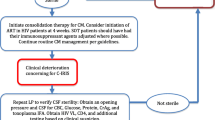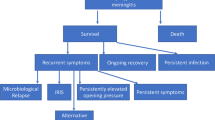Abstract
This review provides an overview of Cryptococcus neoformans immunology and focuses on the pathogenesis of Cryptococcus-related paradoxical immune reconstitution inflammatory syndrome (IRIS). Cryptococcal IRIS has three phases: (1) before antiretroviral therapy (ART), with a paucity of cerebrospinal fluid (CSF) inflammation and defects in antigen clearance; (2) during initial ART immune recovery, with pro-inflammatory signaling by antigen-presenting cells without an effector response; and (3) at IRIS, a cytokine storm with a predominant type-1 helper T-cell (Th1) interferon-gamma (IFN-γ) response. Understanding IRIS pathogenesis allows for risk stratification and customization of HIV/AIDS care. In brief, persons at high IRIS risk may benefit from enhancing microbiologic clearance by use of adjunctive agents in combination with amphotericin, prolonging initial induction therapy, and/or increasing the initial consolidation antifungal therapy dose to at least 800 mg of fluconazole daily until the 2-week CSF culture is known to be sterile. Prophylactic anti-inflammatory therapies or undue delay of ART initiation in an attempt to prevent IRIS is unwarranted and may be dangerous.


Similar content being viewed by others
References
Papers of particular interest, published recently, have been highlighted as: • Of importance
Chayakulkeeree M, Perfect JR. Cryptococcosis. Infect Dis Clin North Am. 2006;20:507–44. v–vi.
Perfect JR. Cryptococcus neoformans: a sugar-coated killer with designer genes. FEMS Immunol Med Microbiol. 2005;45:395–404.
Vecchiarelli A. Immunoregulation by capsular components of Cryptococcus neoformans. Med Mycol. 2000;38:407–17.
Chaka W, Verheul AF, Vaishnav VV, Cherniak R, Scharringa J, Verhoef J, et al. Cryptococcus neoformans and cryptococcal glucuronoxylomannan, galactoxylomannan, and mannoprotein induce different levels of tumor necrosis factor alpha in human peripheral blood mononuclear cells. Infect Immun. 1997;65:272–8.
Kwon-Chung KJ, Rhodes JC. Encapsulation and melanin formation as indicators of virulence in Cryptococcus neoformans. Infect Immun. 1986;51:218–23.
Cherniak R, Sundstrom JB. Polysaccharide antigens of the capsule of Cryptococcus neoformans. Infect Immun. 1994;62:1507–12.
Pietrella D, Cherniak R, Strappini C, Perito S, Mosci P, Bistoni F, et al. Role of mannoprotein in induction and regulation of immunity to Cryptococcus neoformans. Infect Immun. 2001;69:2808–14.
Frases S, Nimrichter L, Viana NB, Nakouzi A, Casadevall A. Cryptococcus neoformans capsular polysaccharide and exopolysaccharide fractions manifest physical, chemical, and antigenic differences. Eukaryot Cell. 2008;7:319–27.
Yauch LE, Mansour MK, Shoham S, Rottman JB, Levitz SM. Involvement of CD14, toll-like receptors 2 and 4, and MyD88 in the host response to the fungal pathogen Cryptococcus neoformans in vivo. Infect Immun. 2004;72:5373–82.
Yauch LE, Mansour MK, Levitz SM. Receptor-mediated clearance of Cryptococcus neoformans capsular polysaccharide in vivo. Infect Immun. 2005;73:8429–32.
Shoham S, Huang C, Chen JM, Golenbock DT, Levitz SM. Toll-like receptor 4 mediates intracellular signaling without TNF-alpha release in response to Cryptococcus neoformans polysaccharide capsule. J Immunol. 2001;166:4620–6.
Levitz SM, Specht CA. The molecular basis for the immunogenicity of Cryptococcus neoformans mannoproteins. FEMS Yeast Res. 2006;6:513–24.
Kozel TR, Wilson MA, Pfrommer GS, Schlageter AM. Activation and binding of opsonic fragments of C3 on encapsulated Cryptococcus neoformans by using an alternative complement pathway reconstituted from six isolated proteins. Infect Immun. 1989;57:1922–7.
van Asbeck EC, Hoepelman AI, Scharringa J, Herpers BL, Verhoef J. Mannose binding lectin plays a crucial role in innate immunity against yeast by enhanced complement activation and enhanced uptake of polymorphonuclear cells. BMC Microbiol. 2008;8:229.
Sallusto F, Cella M, Danieli C, Lanzavecchia A. Dendritic cells use macropinocytosis and the mannose receptor to concentrate macromolecules in the major histocompatibility complex class II compartment: downregulation by cytokines and bacterial products. J Exp Med. 1995;182:389–400.
Wozniak KL, Levitz SM. Cryptococcus neoformans enters the endolysosomal pathway of dendritic cells and is killed by lysosomal components. Infect Immun. 2008;76:4764–71.
• Bicanic T, Muzoora C, Brouwer AE, Meintjes G, Longley N, Taseera K, et al. Independent association between rate of clearance of infection and clinical outcome of HIV associated cryptococcal meningitis: analysis of a combined cohort of 262 patients. Clin Infect Dis. 2009;49:702–9. This article reports on the important association between survival and the quantitative rate of cryptococcal clearance from the CSF.
Siddiqui AA, Brouwer AE, Wuthiekanun V, Jaffar S, Shattock R, Irving D, et al. IFN-gamma at the site of infection determines rate of clearance of infection in cryptococcal meningitis. J Immunol. 2005;174:1746–50.
Jarvis J, Meintjes G, Rebe K, Williams N, Bicanic T, Williams A, et al. Adjunctive IFN-γ immunotherapy for the treatment of HIV-associated cryptococcal meningitis: a randomized controlled trial [Abstract 40]. Presented at the Conference on Retroviruses and Opportunistic Infections (CROI). Boston, MA; Feb 28, 2011.
Voelz K, Lammas DA, May RC. Cytokine signaling regulates the outcome of intracellular macrophage parasitism by Cryptococcus neoformans. Infect Immun. 2009;77:3450–7.
Muller U, Stenzel W, Kohler G, Werner C, Polte T, Hansen G, et al. IL-13 induces disease-promoting type 2 cytokines, alternatively activated macrophages and allergic inflammation during pulmonary infection of mice with Cryptococcus neoformans. J Immunol. 2007;179:5367–77.
• Stenzel W, Muller U, Kohler G, Heppner FL, Blessing M, McKenzie AN, et al. IL-4/IL-13-dependent alternative activation of macrophages but not microglial cells is associated with uncontrolled cerebral cryptococcosis. Am J Pathol. 2009;174:486–96. Using an in vivo murine model, this article demonstrates that Th 2 responses are nonprotective in cryptococcosis.
Conti HR, Shen F, Nayyar N, Stocum E, Sun JN, Lindemann MJ, et al. Th17 cells and IL-17 receptor signaling are essential for mucosal host defense against oral candidiasis. J Exp Med. 2009;206:299–311.
Zelante T, De Luca A, D’Angelo C, Moretti S, Romani L. IL-17/Th17 in anti-fungal immunity: what’s new? Eur J Immunol. 2009;39:645–8.
Hardison SE, Wozniak KL, Kolls JK, Wormley Jr FL. Interleukin-17 is not required for classical macrophage activation in a pulmonary mouse model of Cryptococcus neoformans infection. Infect Immun. 2010;78:5341–51.
Wozniak KL, Hardison SE, Kolls JK, Wormley FL. Role of IL-17A on resolution of pulmonary C. neoformans infection. PLoS One. 2011;6:e17204.
Zelante T, De Luca A, Bonifazi P, Montagnoli C, Bozza S, Moretti S, et al. IL-23 and the Th17 pathway promote inflammation and impair antifungal immune resistance. Eur J Immunol. 2007;37:2695–706.
• Boulware DR, Meya DB, Bergemann TL, Wiesner DL, Rhein J, Musubire A, et al. Clinical features and serum biomarkers in HIV immune reconstitution inflammatory syndrome after cryptococcal meningitis: a prospective cohort study. PLoS Med. 2010;7:e1000384. This article details a prospective Ugandan cohort and the evolving pattern of serum cytokines and chemokines over time that are associated with IRIS.
• Boulware DR, Bonham SC, Meya DB, Wiesner DL, Park GS, Kambugu A, et al. Paucity of initial cerebrospinal fluid inflammation in cryptococcal meningitis is associated with subsequent immune reconstitution inflammatory syndrome. J Infect Dis. 2010;202:962–70. This article reports on the inflammatory cytokines and chemokines present in the CSF of persons with and without IRIS at the time of their initial infection and at the time of IRIS.
• Jarvis J. CSF cytokine profiles in patients with HIV-associated cryptococcal meningitis: correlates with clinical outcome. Presented at the 8th International Conference on Cryptococcus and Cryptococcosis. Charleston, SC; May 4, 2011. This abstract presents confirmatory data on CSF cytokine profiles; an initial paucity of inflammation was associated with later IRIS.
Stone SF, Price P, Keane NM, Murray RJ, French MA. Levels of IL-6 and soluble IL-6 receptor are increased in HIV patients with a history of immune restoration disease after HAART. HIV Med. 2002;3:21–7.
Mosser DM, Edwards JP. Exploring the full spectrum of macrophage activation. Nat Rev Immunol. 2008;8:958–69.
Almeida GM, Andrade RM, Bento CA. The capsular polysaccharides of Cryptococcus neoformans activate normal CD4(+) T cells in a dominant Th2 pattern. J Immunol. 2001;167:5845–51.
Hoag KA, Lipscomb MF, Izzo AA, Street NE. IL-12 and IFN-gamma are required for initiating the protective Th1 response to pulmonary cryptococcosis in resistant C.B-17 mice. Am J Respir Cell Mol Biol. 1997;17:733–9.
Gilliet M, Liu YJ. Human plasmacytoid-derived dendritic cells and the induction of T-regulatory cells. Hum Immunol. 2002;63:1149–55.
McKenna K, Beignon AS, Bhardwaj N. Plasmacytoid dendritic cells: linking innate and adaptive immunity. J Virol. 2005;79:17–27.
Dale DC, Liles WC, Llewellyn C, Price TH. Effects of granulocyte-macrophage colony-stimulating factor (GM-CSF) on neutrophil kinetics and function in normal human volunteers. Am J Hematol. 1998;57:7–15.
van Pelt LJ, Huisman MV, Weening RS, von dem Borne AE, Roos D, van Oers RH. A single dose of granulocyte-macrophage colony-stimulating factor induces systemic interleukin-8 release and neutrophil activation in healthy volunteers. Blood. 1996;87:5305–13.
Chen G-H, Olszewski MA, McDonald RA, Wells JC, Paine III R, Huffnagle GB, et al. Role of granulocyte macrophage colony-stimulating factor in host defense against pulmonary Cryptococcus neoformans infection during murine allergic bronchopulmonary mycosis. Am J Pathol. 2007;170:1028–40.
Bettelli E, Carrier Y, Gao W, Korn T, Strom TB, Oukka M, et al. Reciprocal developmental pathways for the generation of pathogenic effector TH17 and regulatory T cells. Nature. 2006;441:235–8.
Diehl S, Rincon M. The two faces of IL-6 on Th1/Th2 differentiation. Mol Immunol. 2002;39:531–6.
Kambugu A, Meya DB, Rhein J, O’Brien M, Janoff EN, Ronald AR, et al. Outcomes of cryptococcal meningitis in Uganda before and after the availability of highly active antiretroviral therapy. Clin Infect Dis. 2008;46:1694–701.
Bicanic T, Meintjes G, Wood R, Hayes M, Rebe K, Bekker LG, et al. Fungal burden, early fungicidal activity, and outcome in cryptococcal meningitis in antiretroviral-naive or antiretroviral-experienced patients treated with amphotericin B or fluconazole. Clin Infect Dis. 2007;45:76–80.
• Chang CC. Patients with cryptococcal meningitis who attain CSF sterility pre-ART commencement experience improved outcomes in the first 6 months. Presented at the 8th International Conference on Cryptococcus and Cryptococcosis. Charleston, SC; May 5, 2011. This abstract presents convincing data from a prospective cohort on the importance of CSF culture sterility before ART initiation and/or before fluconazole dosing is reduced to fungistatic levels.
Perfect JR, Dismukes WE, Dromer F, Goldman DL, Graybill JR, Hamill RJ, et al. Clinical practice guidelines for the management of cryptococcal disease: 2010 update by the Infectious Diseases Society of America. Clin Infect Dis. 2010;50:291–322.
Bicanic T, Jarvis J, Loyse A, Jackson A, Muzoora C, Wilson D, et al. Determinants of acute outcome and long-term survival in HIV-associated cryptococcal meningitis: Results from a combined cohort of 523 patients [Abstract 892]. Presented at the Conference on Retroviruses and Opportunistic Infections (CROI). Boston, MA; March 3, 2011.
Bahr N, Rolfes MAR, Musubire A, Nabeta H, Lo M, Meya DB, et al. The impact of routine electrolyte supplementation during amphotericin induction therapy in resource-limited settings. Presented at the 8th International Conference on Cryptococcus and Cryptococcosis. Charleston, SC; May 4, 2011.
Longley N, Muzoora C, Taseera K, Mwesigye J, Rwebembera J, Chakera A, et al. Dose response effect of high-dose fluconazole for HIV-associated cryptococcal meningitis in southwestern Uganda. Clin Infect Dis. 2008;47:1556–61.
Grant PM, Komarow L, Andersen J, Sereti I, Pahwa S, Lederman MM, et al. Risk factor analyses for immune reconstitution inflammatory syndrome in a randomized study of early vs. deferred ART during an opportunistic infection. PLoS One. 2010;5:e11416.
• Bicanic T, Meintjes G, Rebe K, Williams A, Loyse A, Wood R, et al. Immune reconstitution inflammatory syndrome in HIV-associated cryptococcal meningitis: a prospective study. J Acquir Immune Defic Syndr. 2009;51:130–4. This cohort is the first prospective study to detail the incidence of Cryptococcus-related IRIS in sub-Saharan Africa.
Acknowledgments
Financial support is received from National Institutes of Health (K23AI073192-02: DRB; U01AI089244-01; DLW). Dr. Boulware thanks collaboration with Drs. Paul Bohjanen, David Meya, Andrew Kambugu, Edward Janoff, Tihana Bicanic, and the Infectious Disease Institute of Makerere University, Kampala, Uganda. We thank Dr. Bicanic for critical review of the manuscript.
Disclosure
Conflicts of Interest: D. Wiesner: none; D. Boulware: research support from GlaxoSmithKline’s HIV Collaborative Investigator Research Award and Merck’s Investigator-Initiated Studies Program; both of these firms manufacture HIV antiretroviral medications.
Author information
Authors and Affiliations
Corresponding author
Rights and permissions
About this article
Cite this article
Wiesner, D.L., Boulware, D.R. Cryptococcus-Related Immune Reconstitution Inflammatory Syndrome (IRIS): Pathogenesis and its Clinical Implications. Curr Fungal Infect Rep 5, 252–261 (2011). https://doi.org/10.1007/s12281-011-0064-8
Published:
Issue Date:
DOI: https://doi.org/10.1007/s12281-011-0064-8




